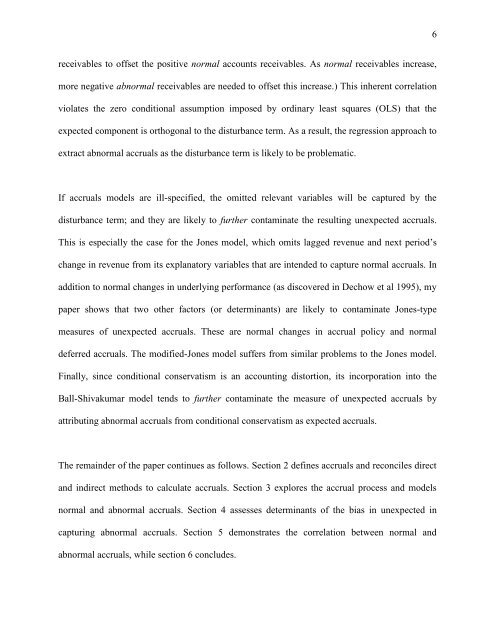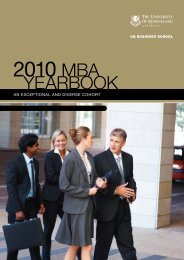Modelling the accruals process and assessing unexpected accruals*
Modelling the accruals process and assessing unexpected accruals*
Modelling the accruals process and assessing unexpected accruals*
Create successful ePaper yourself
Turn your PDF publications into a flip-book with our unique Google optimized e-Paper software.
eceivables to offset <strong>the</strong> positive normal accounts receivables. As normal receivables increase,<br />
more negative abnormal receivables are needed to offset this increase.) This inherent correlation<br />
violates <strong>the</strong> zero conditional assumption imposed by ordinary least squares (OLS) that <strong>the</strong><br />
expected component is orthogonal to <strong>the</strong> disturbance term. As a result, <strong>the</strong> regression approach to<br />
extract abnormal <strong>accruals</strong> as <strong>the</strong> disturbance term is likely to be problematic.<br />
If <strong>accruals</strong> models are ill-specified, <strong>the</strong> omitted relevant variables will be captured by <strong>the</strong><br />
disturbance term; <strong>and</strong> <strong>the</strong>y are likely to fur<strong>the</strong>r contaminate <strong>the</strong> resulting <strong>unexpected</strong> <strong>accruals</strong>.<br />
This is especially <strong>the</strong> case for <strong>the</strong> Jones model, which omits lagged revenue <strong>and</strong> next period‟s<br />
change in revenue from its explanatory variables that are intended to capture normal <strong>accruals</strong>. In<br />
addition to normal changes in underlying performance (as discovered in Dechow et al 1995), my<br />
paper shows that two o<strong>the</strong>r factors (or determinants) are likely to contaminate Jones-type<br />
measures of <strong>unexpected</strong> <strong>accruals</strong>. These are normal changes in accrual policy <strong>and</strong> normal<br />
deferred <strong>accruals</strong>. The modified-Jones model suffers from similar problems to <strong>the</strong> Jones model.<br />
Finally, since conditional conservatism is an accounting distortion, its incorporation into <strong>the</strong><br />
Ball-Shivakumar model tends to fur<strong>the</strong>r contaminate <strong>the</strong> measure of <strong>unexpected</strong> <strong>accruals</strong> by<br />
attributing abnormal <strong>accruals</strong> from conditional conservatism as expected <strong>accruals</strong>.<br />
The remainder of <strong>the</strong> paper continues as follows. Section 2 defines <strong>accruals</strong> <strong>and</strong> reconciles direct<br />
<strong>and</strong> indirect methods to calculate <strong>accruals</strong>. Section 3 explores <strong>the</strong> accrual <strong>process</strong> <strong>and</strong> models<br />
normal <strong>and</strong> abnormal <strong>accruals</strong>. Section 4 assesses determinants of <strong>the</strong> bias in <strong>unexpected</strong> in<br />
capturing abnormal <strong>accruals</strong>. Section 5 demonstrates <strong>the</strong> correlation between normal <strong>and</strong><br />
abnormal <strong>accruals</strong>, while section 6 concludes.<br />
6



